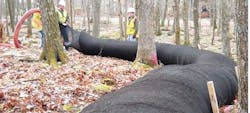From Grey to Green
How does a designer reduce flooding and provide water quality improvement in a wooded, 4,600-acre development with no storm water infrastructure except ditches? Deforestation and installation of basins no longer are accepted BMPs. Now, green storm water infrastructure (GSI) practices provide peak flow reduction and improve water quality by mimicking natural conditions (e.g., by maximizing infiltration and evapotranspiration).
According to the U.S. Environmental Protection Agency, “Green infrastructure is an approach that communities can choose to maintain healthy waters, provide multiple environmental benefits and support sustainable communities. Unlike single-purpose grey storm water infrastructure—which uses pipes to dispose of rainwater—green infrastructure uses vegetation and soil to manage rainwater where it falls.”
Hemlock Farms Project
The Hemlock Farms community in Pennsylvania’s Pocono Mountains is a 4,600-acre development that contained 3,600 homes, 75 miles of roadway, 100 acres of lakes—and no modern storm water management. The development was designed in the 1960s as a dense grid of ¾-acre lots. As the community approached build-out, major problems developed, including localized flooding, poor water quality in the lakes and erosion.
The project needed to be specifically designed to stop washout due to erosion of large portions of the road system. Of the 75 miles of road within the community, 42 miles were affected by flooding and shoulder erosion. Community leaders proactively chose to develop a GSI solution to address these problems.
A solution was designed to blend into the landscape and treat runoff along its entire flow path, with a primary focus on treatment at the source and the reduction of runoff volume through evapotranspiration and base flow enhancement. Kleinschmidt, an engineering firm in Strasburg, Pa., developed a new GSI solution to save trees, which involved using 32-in. Filtrexx SiltSoxx filled with media called Retentive Grading. Kleinschmidt worked with Hunt Ventures of Gettysburg, Pa., on the design, which in turn brought in Ground Solutions of Waynesboro, Pa., on the SiltSoxx installation.
Retentive Grading is designed to mimic a natural floodplain, providing peak flow reduction and water quality while balancing infiltration and evapotranspiration. The practice involves creating a berm perpendicular to the slope, allowing the water to pond on the forested site, reducing the flow rate of storm water. Water quality is improved when the water is allowed to settle in storage areas and slowly pass through the SiltSoxx for filtration. This practice also improves the plants’ uptake of the nutrients in the soil. Over time, this practice creates an upper floodplain where hardwood species thrive, and a lower floodplain to house other woodland species.
The effectiveness of green infrastructure on reducing flooding was not initially accepted by the community because of antiquated regulations. In this community, SiltSoxx was considered a new BMP, which required discussions with regulators to gain acceptance, including the Pennsylvania Department of Environmental Protection and the Pike County Conservation District. Therefore, a new regulatory framework was developed for this project.
Funding of the project required solutions including a storm water utility fee and market trading of watershed improvements to downstream developers, which is based on nutrient trading principles.
“SiltSoxx made designing to fit the landscape easy,” said Mark Bowen, senior ecological engineer for Kleinschmidt. “We were able to reduce tree removal, soil disturbance and the overall project footprint. It will improve water quality and reduce the flooding in the future.”
Hemlock Farms has plans to install another 18 SiltSoxx to control erosion and flooding.
Download: Here


